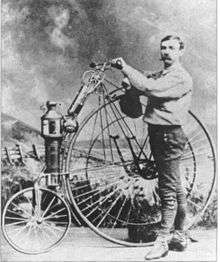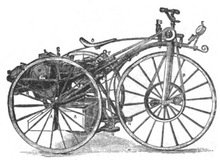Lucius Copeland
Lucius Day Copeland was a pioneering 19th-century engineer and inventor from Phoenix, Arizona who demonstrated one of the first motorcycles, the Copeland steam bicycle, a steam-powered Star high-wheeler at the first Arizona Territorial Fair in 1884.[1]
Lucius Day Copeland | |
|---|---|
 Lucius Copeland and his steam bicycle, 1884 | |
| Nationality | United States |
| Occupation | Engineer and inventor |
Three-wheeler

Copeland also invented the first successfully mass-produced three-wheeled car. About 200 of his "Phaeton steamers" were produced[2] before he retired in 1891.[3] Copeland had produced the first successful steam tricycle, with a range of 30 miles (48 km) and taking only 5 minutes to build up enough steam to average 10 miles per hour (16 km/h).[4] Accompanied by another director of Northrop Manufacturing, Copeland successfully completed a return trip to Atlantic City of 120 miles (190 km) in one of his three-wheeled "Phaeton steamers". About 200 were produced[2] before Copeland decided that he wasn't making enough money and retired in 1891.[3]
References
- Gagan, Peter. "Earliest Steam Cycles". stanleysteamers.com. Retrieved 23 September 2010.
- Barnard, Murray (1996). "The Copeland Steamer". ozebook.com. Retrieved 23 September 2010.
- Payne, Elvis (2010). "Copeland". 3wheelers.com. Retrieved 23 September 2010.
- Schindler, Gordon (June 2002). The Age of Steam. American Motorcyclist. Retrieved 23 September 2010.
External links
| Wikimedia Commons has media related to Lucius Copeland. |
